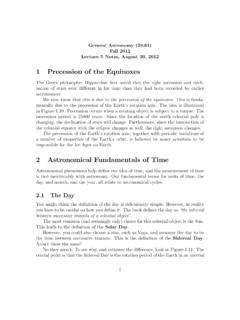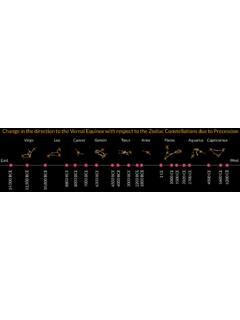Transcription of On the possible discovery of precessional effects in ...
1 1On the possible discovery of precessional effects in ancient astronomy. Giulio Magli Dipartimento di Matematica del Politecnico di Milano Leonardo da Vinci 32, 20133 Milano, Italy. Abstract: The possible discovery , by ancient astronomers, of the slow drift in the stellar configurations due to the precessional movement of the earth s axis has been proposed several times and, in particular, has been considered as the fundamental key in the interpretation of myths by Ugo de Santillana and Ertha Von Dechend. Finding clear proofs that this discovery actually occurred would, therefore, be of relevant importance in a wide inter-disciplinary area of sciences which includes both social-historical and archaeo-astronomical research. In the present paper the possible discovery of astronomical effects induced by precession - such as the shift in the declination of the heliacal raising of bright stars or the so called precession of the equinoxes - is analysed for various ancient cultures in the world.
2 Although definitive evidence of the discovery is still lacking, the quantity of hints emerging from the general picture is impressive and stimulating in view of further research. Plan of the paper: 1 Introduction 2 Astronomical data Babylonian culture The indo-savrastati culture Egypt : Middle and New Kingdom astronomical data The maya 3 Astronomical alignments Egypt : orientation of temples Egypt : orientation of pyramids Malta Majorca Sardinia The Medicine wheels Teutihuacan and the 17 degree family 4 Post- discovery hints The cult of Mithras The Gundestrup cauldron 5 Concluding remarks Acknowledgements References 2 1 Introduction The earth rotates around its axis in 24 hours, and the earth s axis rotates around the axis orthogonal to the ecliptic, describing a cone. Thus, the motion of the earth is similar to that of a top: the earth precedes. The period of this movement is extremely long with respect to human life, since the axis completes a cycle in 25776 years.
3 precession has a very important consequence on long-term naked eye astronomy. First of all, the prolongation of the earth axis on the celestial sphere defines astronomical north. The direction in which astronomical north points possibly indicating a star, thereby a pole star changes therefore continuously in time. Today s pole star (our Polaris) will resign to be the pole star in a few centuries, and all the stars which lie close to the circle described by the pole (actually not exactly a closed circle, due to perturbations) will become pole stars one time each precessional cycle. For instance, in Palaeolithic times, the north pole crossed the Milky Way and the Pole star in 15000 BC was Delta-Cygnus. The north-pole sky was therefore completely different from ours; it was probably depicted in a fresco of the famous Lascaux grotto (Rappenglueck 1998). Fig. 1 The circle described in the sky by the north celestial pole during a precessional cycle Although at best visualized using the movement of the north pole (or actually of the south pole, choice of north is only due to the latitude of the present author at the moment of writing) precessional effects act on all stars.
4 For instance, precession slowly moves the rising point of non-circumpolar stars and slowly moves the culmination of stars: it follows, that the whole visible sky in a given point at a given time depends on the precessional moment . As an example, one can consider the constellation of the group of stars Crux-Centaurus at the latitudes of the Mediterranean sea (the South Cross constellation was isolated as a standing constellation only the 16 century AD). This asterism was quite important for people living at that latitudes in very ancient times, as the research by Michael Hoskin and collaborators on megalithic structures in the Baleary Islands and in Malta has shown (we shall come back on this later). However, the Crux-Centaurus group became lower and lower at the horizon during the centuries, and today it culminates below the 3south horizon due to precession and it is, therefore, invisible (it will be back here only in 12000 AD). The question now arises, when was the discovery of precession actually achieved.
5 Standard scientific point of view states the following: 1) precession was first discovered around 128 BC by Hipparchus of Rhodes 2) precession was never discovered in pre-Columbian cultures, in other words it was not known in the Americas before Columbus In spite of this, the very opposite idea that actually all archaic civilizations discovered precession very early has been around for a long time and was stated in a authoritative way by Ugo de Santillana and Ertha Von Dechend (1983) in their famous book Hamlet s Mill. Santillana and Von Dechend actually put the discovery of precession as the common root of most, if not all, cosmological myths around the world. Altough being an extremely interesting and worth reading book, the Hamlet s Mill cannot be of any help when discussing the basic issue of the discovery of precession , since all the proofs recorded in it cannot be considered as true scientific proofs. Indeed the authors report an (albeit impressive) amount of occurrences of similar images, same numbers, similar situations in several cosmological myths around the world.
6 Altough it is well known that the myth has actually been used also as a technical language, without a independent, rigorous verification it is of course impossible to accept images and numbers as proofs . The aim of the present paper is to analyse in a systematic way the hints that we really have pointing to the discovery of precession before Hipparchus in ancient cultures. To the best of my knowledge this is the first time that such a systematic attempt is made, and it is my hope that the work can contribute to stimulate further research in this field. 2 Astronomical data It is nearly impossible for a naked-eye astronomer (even if very old and expert) to discover precession in the course of his own life using only his own observations, due to the extremely slow nature of the phenomenon with respect to the length of human life. It is, however, sufficient to have astronomical data collected during - say - two or three centuries, and to trust in them, to become aware that something is happening in the sky with a very low, but measurable, velocity (this is exactly what happened to Hipparchus: he collected a great quantity of astronomical data over more than 800 celestial objects coming from the Alexandria observatory and based his discovery on such data).
7 I shall, thus, be concerned here with the discovery that something is happening . This means, that I am not speaking about the possible discovery of the actual mechanism and/or of the length of the precessional cycle (although this discovery is not a priori excluded) but rather, of the observation of a discrepancies in specific sets of data: from now on I will call them precessional effects . Typical examples may include the observation of the precessional Era namely, the fact that the sun at the spring equinox rises in different places within a constellation and finally changes constellation every 2000 years, or the observation of the changes of declination of heliacal rising, or height of transit, of a star. Babylonian culture In Mesopotamia, astronomers have been collecting astronomical data on argilla tablets for thousands of years. Their records contain observations which are more precise than one minute of arc. Since it is nearly impossible to obtain such an accuracy at naked eye, it was probably reached with the first spyglasses ever invented (Pettinato 1998).
8 4 One example of a Babylonian star catalogue is the famous Mul-apin. Probably written around 1000 BC, it contains astronomical data which can be traced back in time up to 2048 BC. The content includes: 1) A list of 71 celestial objects (constellations, single stars and the five planets) divided in three courses (Enlil, Anu ed Ea). 2) A list of heliacal rising of many stars 3) A list of simultaneous rising/settings of couples of stars 4) A list of time delays between the rising of the same stars 5) A list of simultaneous transit/rising of some others couples of stars. It is difficult to believe, that astronomers possessing data so accurate did not notice the effect of precession , an idea put forward more than one century ago by the so-called Panbabylonists. As a matter of fact, however, no written record citing the phenomenon explicitly has been discovered so far. The indo-savrastati culture The history of the Indian civilization has been plagued by the fool and anti-historical idea of the so called Arian invasion.
9 The basis of this idea was that civilization was brought in India by indo-European people, the Arians, around 1000 BC. After the discovery of the 2500 BC towns of Harappa and Moenjo-daro, the Arians started to be considered warriors and invaders, but the idea remained, that the fundamental books of the Hindu religion, the Veda, where conceived after this invasion. Today, however, we finally do know that the Arians simply never existed and that the Indian civilization (traditionally associated with the sites of Harappa and Moenjo-daro, but actually much more spread than the area individuated by these two cities) developed in between two rivers, the Indo and the Savrastati river (Feuerstein, Kak, and Frawley 1995). The Veda contain explicit reference to the latter river, which however drought around 1900 BC, and thus the books (actually memo-books learned by memory by Brahmins) are at least as old as that period. Together with this new approach to the Veda, in recent years a new approach to what we can now call Vedic astronomy emerged (Kak 2000).
10 In Vedic astronomy a fundamental role is played by the five visible planets, the sun, and the moon, identified with seven fundamental deities. However, to keep track of the motion of them, 27 astronomical objects were used, the Naksatras, asterisms/constellations used to divide the ecliptic in equal parts, in each one the sun is resting about 13 and 1/3 days. Naksatras occur in ordered lists. For instance, one reads (with modern names) Pleiades, alfa-tauri (Aldebaran) , beta-tauri, gamma-gemini, beta-gemini (Pollux), delta-cancri, Hidra, Regolus, and so on. Interestingly enough, lists of Naksatras belonging to different periods contain the same objects but begin in different points. The starting point is individuated by the sun at the spring equinox, and this means that Vedic astronomers were almost certainly aware that the Sun was changing Naksatra with a velocity of more than one Naksatra per millennium (25776/27). Egypt : Middle and New Kingdom astronomical data The study of the ancient astronomy in Egypt has been plagued for many years by the influence of the most important scholar in the field, Otto Neugebauer, who stated in several occasions assertions like this: Egypt did not contribute to the history of mathematical astronomy (see Neugebauer 1969, 1976).









